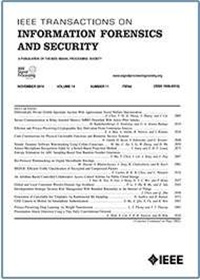超大规模MIMO近场多用户系统密钥生成的预编码设计
IF 8
1区 计算机科学
Q1 COMPUTER SCIENCE, THEORY & METHODS
IEEE Transactions on Information Forensics and Security
Pub Date : 2025-09-25
DOI:10.1109/TIFS.2025.3614468
引用次数: 0
摘要
本文提出了一种利用大规模多输入多输出(xml - mimo)近场多用户通信中的人工随机性为合法用户生成共享密钥的物理层密钥生成(PLKG)方案。与依赖无线信道变化的传统PLKG方案不同,该方法通过预编码矢量引入噪声功率,在视距(LoS)信道中产生动态波动,模拟在快速衰落信道中通常观察到的快速变化。这种人为的随机性保证了用户设备能够生成密钥,同时有效防止恶意窃听者的潜在窃听。特别地,设计了一种新的信道探测协议,利用近场通信中终端之间距离和空间角度的差异,利用非正交导频,使多个终端能够同时与基站商定密钥。其次,为了使密钥率最大化,提出了一种交替优化算法,解决了两个子优化问题。第一个子问题采用奇异值分解(SVD)方法分别识别用于生成密钥和防止窃听攻击的合法空间及其正交子空间。随后,提出了一种基于Dinkelbach方法的功率分配算法,将噪声功率分配到这两个空间。第二个子问题使用充水算法实现多个ue之间的功率分配。最后,为了解决交替优化问题中未考虑预编码噪声的问题,引入了一种基于深度学习的方法,进一步提高了方案的性能。仿真结果表明,所提出的PLKG方案优于现有方案。本文章由计算机程序翻译,如有差异,请以英文原文为准。
Precoding Design for Key Generation in Extremely Large-Scale MIMO Near-Field Multi-User Systems
This paper develops a physical layer key generation (PLKG) scheme that utilizes artificial randomness in extremely large-scale multiple-input multiple-output (XL-MIMO) near-field multi-user communications to produce shared secret keys for legitimate users. Unlike traditional PLKG schemes, which rely on the variation of wireless channels, this approach introduces noise power via the precoding vectors to create dynamic fluctuations in the line-of-sight (LoS) channels, emulating the rapid changes typically observed in fast-fading channels. This artificial randomness ensures that the user equipment (UEs) can generate secret keys while effectively preventing potential eavesdropping from malicious eavesdroppers. In particular, a novel channel probing protocol is designed, enabling multiple UEs to simultaneously agree on secret keys with the base station (BS) using non-orthogonal pilots, which exploits the difference in the distances and spatial angles of UEs in near-field communications. Secondly, to maximize the secret key rate, an alternating optimization algorithm is proposed, solving two sub-optimization problems. The first sub-problem employs the singular value decomposition (SVD) method to identify the legitimate space and its orthogonal subspace for generating secret keys and preventing eavesdropping attacks, respectively. Subsequently, a Dinkelbach method-based power allocation algorithm is developed to allocate noise power to these two spaces. The second sub-problem uses a water-filling algorithm to implement power allocation among multiple UEs. Finally, to address the issue of precoding noise not being considered in the alternating optimization problem, a deep learning-based method is introduced, which further improves the performance of the scheme. Simulations demonstrate the efficiency of the proposed PLKG scheme over existing schemes.
求助全文
通过发布文献求助,成功后即可免费获取论文全文。
去求助
来源期刊

IEEE Transactions on Information Forensics and Security
工程技术-工程:电子与电气
CiteScore
14.40
自引率
7.40%
发文量
234
审稿时长
6.5 months
期刊介绍:
The IEEE Transactions on Information Forensics and Security covers the sciences, technologies, and applications relating to information forensics, information security, biometrics, surveillance and systems applications that incorporate these features
 求助内容:
求助内容: 应助结果提醒方式:
应助结果提醒方式:


